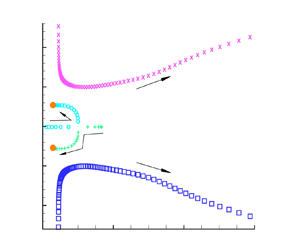Article contents
Damped shape oscillations of a viscous compound droplet suspended in a viscous host fluid
Published online by Cambridge University Press: 01 December 2021
Abstract

A study of small-amplitude shape oscillations of a viscous compound droplet suspended in a viscous host fluid is performed. A generalized eigenvalue problem is formulated and is solved by using the spectral method. The effects of the relevant non-dimensional parameters are examined for three cases, i.e. a liquid shell in a vacuum and a compound droplet in a vacuum or in a host fluid. The fundamental mode  $l=2$ is found to be dominant. There exist two oscillatory modes: the in phase and the out of phase. In most situations, the interfaces oscillate in phase rather than out of phase. For the in-phase mode, in the absence of the host, as the viscosity of the core or the shell increases, the damping rate increases whereas the oscillation frequency decreases; when the viscosity exceeds a critical value, the mode becomes aperiodic with the damping rate bifurcating into two branches. In addition, when the tension of the inner interface becomes smaller than some value, the in-phase mode turns aperiodic. In the presence of the unbounded host fluid, there exists a continuous spectrum. The viscosity of the host may decrease or increase the damping rate of the in-phase mode. The mechanism behind it is discussed. The density contrasts between fluids affect oscillations of the droplet in a complicated way. Particularly, sufficiently large densities of the core or the host lead to the disappearance of the out-of-phase mode. The thin shell approximation predicts well the oscillation of the compound droplet when the shell is thin.
$l=2$ is found to be dominant. There exist two oscillatory modes: the in phase and the out of phase. In most situations, the interfaces oscillate in phase rather than out of phase. For the in-phase mode, in the absence of the host, as the viscosity of the core or the shell increases, the damping rate increases whereas the oscillation frequency decreases; when the viscosity exceeds a critical value, the mode becomes aperiodic with the damping rate bifurcating into two branches. In addition, when the tension of the inner interface becomes smaller than some value, the in-phase mode turns aperiodic. In the presence of the unbounded host fluid, there exists a continuous spectrum. The viscosity of the host may decrease or increase the damping rate of the in-phase mode. The mechanism behind it is discussed. The density contrasts between fluids affect oscillations of the droplet in a complicated way. Particularly, sufficiently large densities of the core or the host lead to the disappearance of the out-of-phase mode. The thin shell approximation predicts well the oscillation of the compound droplet when the shell is thin.
JFM classification
- Type
- JFM Papers
- Information
- Copyright
- © The Author(s), 2021. Published by Cambridge University Press
References
REFERENCES
- 2
- Cited by



